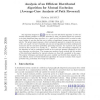376 search results - page 6 / 76 » General Reversibility |
CONPAR
1992
14 years 20 days ago
1992
The algorithm designed in [12, 15] was the very first distributed algorithm to solve the mutual exclusion problem in complete networks by using a dynamic logical tree structure as...
AMAST
2006
Springer
14 years 10 days ago
2006
Springer
Abstract. Accumulation techniques were invented to transform functional programs, which intensively use append functions (like inefficient list reversal), into more efficient progr...
ICICS
2005
Springer
14 years 2 months ago
2005
Springer
A reversible watermarking algorithm with large capacity has been developed by applying the difference expansion of a generalized integer transform. In this algorithm, a watermark ...
IJAC
2006
13 years 8 months ago
2006
It has been conjectured that in a braid group, or more generally in a Garside group, applying any sequence of monotone equivalences and word reversings can increase the length of a...
SIGMOD
2006
ACM
14 years 8 months ago
2006
ACM
The reverse k-nearest neighbor (RkNN) problem, i.e. finding all objects in a data set the k-nearest neighbors of which include a specified query object, is a generalization of the...

